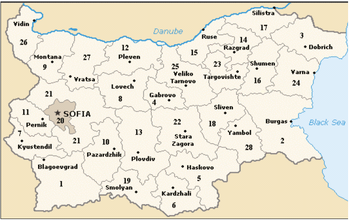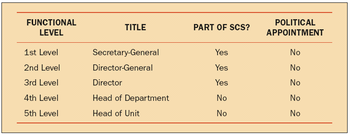Archive:Public employment - Estonia
- Data from Month Year. Most recent data: Further Eurostat information, Main tables and Database.
<Introduction: simple language, not too long, kind of executive summary>
Regional and administrative organisation
Introduction
The Republic of Estonia (Eesti Vabariik) has belonged to the European Union (EU) and NATO since 2004. Estonians are ethnic and the Estonian language shows many similarities to Finnish and they have close historical and cultural ties to Scandinavia, unlike the other two Baltic countries. It is an independent, sovereign and democratic republic.
System of government
Supreme power lies with the people who elect the “Riigikogu” (Parliament). The President is the Head of State, but the Riigikogu and the Government exercise legislative and executive power. The functions of the executive are divided into Government areas managed by Ministries. The State Chancellery (Government Agency) supports the Government and the Prime Minister.
The political and administrative systems are interrelated in the Ministries. 11 ministries are responsible for the organization of areas of government. The ministries are managed by political, ministers working in them. Constitutional Institutions consist of Chancellery of the Riigikogu, Office of the Legal Chancellor, Office of the President, Supreme Court, State Audit Office. Ministers (politicians and members of the central government) are the heads of the Ministries and the Government Agencies. The regulation that controls the Government of the Republic classifies the agencies of the Executive Power as follows: Government Agencies; State Agencies administered by the former.
Government Agencies are administrative agencies (Ministries, the State Chancellery, County Government, Executive Agencies and Inspectorates, their Regional Offices, etc.). They are funded through the state budget and their main function is to exercise Executive Power.
]
Regional organisation
Estonia is a unitary State without self-governing regions which is divided into Counties, rural municipalities and cities (193 rural municipalities and 33 cities which in turn form 15 Counties). The Constitution forbids the establishment of self-governing regions or the creation of a Federal State. Local affairs are managed autonomously by local governments, which are the rural municipalities and cities, on which obligations may be imposed by law or via agreements with the local government.
The country is divided into 15 Counties (maakonnad) as administrative sub-divisions. The County Government (maavalitsus) of each county is headed by a Governor (maavanem), appointed for 5 years, as the central government’s representative at regional level.
The regional level of the administrative system includes: county governments, and
- regional offices of executive agencies, inspectorates and regional associations of
municipalities. Each Local Government of the 226 cities and rural municipalities has an administrative mechanism for the local government and its inhabitants. The number of administration staff depends on the size of the municipality (from 1,000 public servants in Tallinn to less than 5 in small municipalities). At local level, the 193 rural municipalities (vald) and the 33 towns (linn) are responsible for organizing the areas of education, housing, leisure, etc within the area of a local government unit.
The administrative system currently has the following levels: National: the State Chancellery, Ministries, Executive Agencies, Inspectorates and Government Agencies.
Public administration
The Council of Ministers creates, modifies and eliminates the Administration bodies below the ministerial level, as well as the executive agencies and state commissions (individual corporate bodies under the central bodies of the Executive Power) by Royal Decree. The general administrative model essentially determines the types of administrative structure according to their functions, general principles and organization.
Central Administration has the following structure: Administration of the Council of Ministers; Ministries; State Agencies; Peripheral Administration and Executive Agencies. Territorial Administration consists of regional and municipal administration.
State Agencies are directly accountable to the Council of Ministers, and deal with the administration for the implementation of activities that are not the competence of a Ministry. They are a corporate body with a specific budget. The Decree establishes their functions and administrative organization, led by a President appointed by this Council.
Public employment structure
Regulations
The 1999 Civil Service Act establishes two types of Public Employees: Civil Servants and Non-civil service employees, whose employment contract may be indefinite or temporary. A trial period of 6 months is common. Both types of employees occupy positions listed in the “Unified classifier of administrative positions”, which includes the distribution of positions into levels, minimum entry requirements as well as their legal nature. Depending on the functions, the positions are: Manager (reserved for civil servants); Expert and Technician.
Public Employment Management Body: Management of public employees is carried out by the Secretary-General of the corresponding Administration. The Ministry for State Administration and Administrative Reform is the institution responsible for the human resources policy of the State Administration. There are 83,943 public employees (47.1% of which are civil servants and 53.3% are contractual staff) serving a total population of 7.7 million inhabitants.
Rights, obligations, principles and values
Rights and Obligations are established by law and include, among others: the obligation of secrecy, political neutrality, hierarchical obedience, unless the order given is evidently illegal. Public employees also have the right to freedom of speech and the right to join a union. Civil servants do not have the right to strike.
The Law allows civil servants to provide some services under an employment contract, but the administration must be informed so as to avoid conflicts of interest. As civil servants, they may only work part time as university professors.
The work of all civil servants is assessed through an “attestation”, which is prepared in three phases: Making a draft and co-ordinating a working plan at the beginning of the period; A meeting half-way through the period; A final meeting and assessment – before giving a final score at the end of the period (1st-30th November).
This procedure evaluates:
- the degree of fulfilment of the aims set out in the working plan;
- the degree of fulfilment of the obligations laid down for this post;
- the necessary competence for this post.
The assessment is carried out by the Evaluation Manager with the participation of union representatives. For the positions of Director-General and Director of Directorate, the Head of Evaluation is normally the Secretary-General.
According to Bulgarian Labour Law, each Administration reports the overtime of its employees over a 6-month period to the Chief Labour Inspectorate, which is remunerated, in accordance with the amount regulated by Law. This does not apply to civil servants. Civil servants are entitled to additional leave (apart from the general leave determined in the Labour Law and in the Civil Service Act) according to their position, up to a maximum 15 days.
Career-based system and training
Career: This is mainly based on the position. There are mobility programmes for civil servants, who can transfer to another administration provided that they have completed a probationary period of one year, that there is an agreement between both administrations and they fulfil the requirements for the post. The Law regulates permanent and temporary mobility.
Training: When service requirements arise, training costs shall be borne by the administration. Each administration presents a Training Plan for its civil servants each year. In the State sphere, this plan is reviewed by the Minister of State Administration and Administrative Reform, who will approve it and take care of the annual budgetary allowance for this concept.
Training of state public employees is carried out by an executive Agency, dependent on the aforementioned Ministry, the Public Administration and European Integration Institute. Training is compulsory at the beginning of public service and for civil servants appointed to managerial positions for the first time. Senior civil servants must pass a training programme organised by the Public Administration Institute at least once a year.
Remuneration
The Civil Service Act regulates the official minimum salary for public employees. The basic salary may be increased in accordance with work performance.
Social dialogue and system of representation
The main trade unions in the Social Dialogue are the Confederation of Independent Trade Unions and the Confederation of Podkrepa Labour. The trade unions take part in the determination of wages, working conditions, holidays, etc., for public employees. Around 25 to 40% of civil servants are members of a union. Negotiations take place within the tripartite National Council, which consists of 2 representatives of the Council of Ministers, 2 representatives of the trade unions and 2 representatives of the employer. It is presided over by the Deputy Prime Minister. Trade unions and employers elect a Vice-Chairman on the principle of rotation. The results of collective bargaining must be implemented, and they therefore take the form of a legal text or political agreement.
There are no differences in the institutional framework between employment relations in the public and private sector, but there are specific conditions regarding education, health or culture.
Senior civil servants
]
There is no special equality policy for women in senior civil service positions. This type of personnel has a one year probationary period.
Recent reforms and prospects
In 2002, the Council of Ministers drew up an e-administration strategy to improve on- line relations with citizens, making them play a role in decision-making, as well as an anti-corruption strategy, with the creation of a Commission for this purpose. Laws have also been approved regarding the rights and obligations of public employees, conflicts of interests, efficiency and transparency in recruitment processes and the development of fiscal controls.
Further Eurostat information
Publications
Main tables
- Title(s) of second level folder (if any)
- Title(s) of third level folder (if any)
Database
- Title(s) of second level folder (if any)
- Title(s) of third level folder (if any)
Dedicated section
Methodology / Metadata
<link to ESMS file, methodological publications, survey manuals, etc.>
- Name of the destination ESMS metadata file (ESMS metadata file - ESMS code, e.g. bop_fats_esms)
- Title of the publication
Source data for tables, figures and maps (MS Excel)
Other information
<Regulations and other legal texts, communications from the Commission, administrative notes, Policy documents, …>
- Regulation 1737/2005 of DD Month YYYY on ...
- Directive 86/2003 of DD Month YYYY on ...
- Commission Decision 86/2003 of DD Month YYYY on ...
<For other documents such as Commission Proposals or Reports, see EUR-Lex search by natural number>
<For linking to database table, otherwise remove: {{{title}}} ({{{code}}})>

